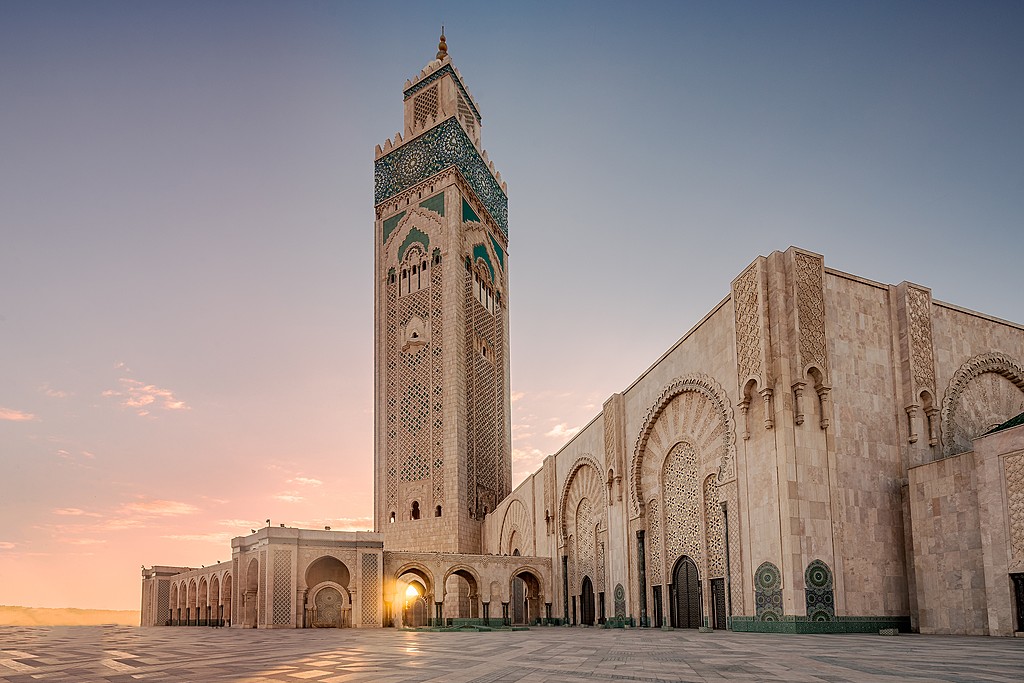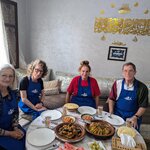Highlights
- Explore the art-filled streets of seaside Asilah
- Camp under the stars in the sand dunes of Erg Chebbi
- Follow an expert guide through the medinas of Fes and Marrakech
- Learn to cook Moroccan food in the markets of Essaouira
Brief Itinerary
| Day | Highlights | Overnight |
|---|---|---|
| Day 1 | Arrive in Casablanca & Transfer to Asilah | Asilah |
| Day 2 | Explore Asilah | Asilah |
| Day 3 | Asilah to Fes via Meknes & Volubilis | Fes |
| Day 4 | Guided Tour of Fes | Fes |
| Day 5 | Fes to Midelt | Midelt |
| Day 6 | Midelt to Merzouga Camel Trek | Merzouga |
| Day 7 | Merzouga to Dades Valley | Boumalne Dades |
| Day 8 | Day with the Locals in the Valley of Roses | Boumalne Dades |
| Day 9 | Dades Valley to Marrakech via Ait Ben Haddou | Marrakech |
| Day 10 | Guided Tour of Marrakech | Marrakech |
| Day 11 | Marrakech to Essaouira | Essaouira |
| Day 12 | Cooking Class in Essaouira | Essaouira |
| Day 13 | Essaouira to Casablanca | Casablanca |
| Day 14 | Depart Casablanca |
Detailed Itinerary
Day 1: Arrive in Casablanca & Transfer to Asilah

Welcome to Morocco!
You'll land at the airport in Casablanca, then catch your transfer to the picturesque seaside city of Asilah. In this small walled city, art is everywhere, from the murals that can be discovered around every corner to the artists selling their work on the sidewalks. Even children display their artwork for all to see. Be sure to head to the ramparts in the evening to watch the sun set over the Atlantic Ocean.
Day 2: Explore Asilah

Spend a free day exploring Asilah (and working off your jet lag). This small seaside city is home to historic architecture, pristine beaches, and local culture in a thriving artistic community. Its walls are whitewashed anew every year for a fresh crop of murals, so there's always new art waiting around the corner. If you'd like to bring some home with you, pop into one of the many artists' studios in the medina, then sample the catch of the day at the nearby seafood stalls.
The town's history dates back to the Phoenicians in 1500 BCE. It passed through Portuguese, Spanish, and Moroccan control throughout its history, and is now home to weekend getaways for wealthy residents of Casablanca and hosts regular music and art festivals.
Day 3: Asilah to Fes via Meknes & Volubilis

Head inland to the lesser-known imperial city of Meknes. Your visit will begin by entering the old medina through the unique gate of Bab El-Mansour, which incorporates marble pillars that were taken from the Roman ruins of Volubilis.
Once inside the medina, you will visit the tomb of Sultan Moulay Ismail. It was under this ruler’s reign from 1672 to 1727 that Meknes served its time as the capital of Morocco. This ruler's eccentricity—which some might describe as paranoia—is evident throughout the city, from the extra thick medina walls to the underground prison located below the room where he greeted foreign dignitaries.
Next, you'll visit Heri Es Souani, the former granary, and the ruins of the royal stable that once housed more than 10,000 horses, located next to the impressive Agdal Reservoir. If the reservoir brings to mind the Grand Canal of Chateaux Versailles, this is no accident. As a contemporary of Louis XIV, Moulay Ismail built his city to rival the famous Chateaux. After your guided tour of Meknes, you'll head to nearby Volubilis for a tour of the ruins before making the short drive to Fes, where you'll spend the night.
Day 4: Guided Tour of Fes

Set out for a guided tour of the city with a local expert today. You'll start at the Royal Palace and walk through the old Jewish Quarter, up to one of the Borj towers for a panoramic view of the medina. Next, you’ll head to a mosaic house where you will have a demonstration of the traditional pottery methods utilized by Fassi artisans – you’ll see every step of the process from the formation of the clay to the piecing together of the mosaics.
After the demonstration, the tour will take you into the medina of Fes where you will discover the ancient streets and neighborhoods, visit the various artisan sections (including the tanneries), and see the important historic monuments, including the tomb of Idriss II and the Al-Qarawaiyin University, the oldest continually operated university in the world. Your tour will end after lunch, at which time you’ll have the rest of the afternoon and evening free to explore the medina. Don’t worry if you get lost—that is all part of the experience.
Day 5: Fes to Midelt

Leave Fes to head into the desert. On the way, you will travel through the largest cedar forest in Africa, which is also home to the Barbary apes (aka Atlas Monkeys), which are sure to entertain. You’ll cross the Middle Atlas Mountains to Midelt, on the high plains between the Middle and High Atlas Mountains, where you will stop for the night.
After you arrive, take a short walk in the ecological park to check out the local flora and fauna. Make sure to sample the specialty local trout caught in the volcanic lakes while you're here, then grab a bottle of wine and watch the local wildlife in the pond under the shadow of the Atlas Mountains.
Day 6: Midelt to Merzouga Camel Trek

Head into the High Atlas Mountains via the Ziz River Gorge to the large dunes of Erg Chebbi. Take some time to explore the area around the dunes before meeting your camels and trekking into the heart of the dunes to your luxury camp for the night. (If camels aren't quite your style, you can opt for a 4x4 instead.)
Once you arrive, you can climb the nearest dune to watch the sun go down and the stars come out. Enjoy dinner, traditional music, and stargazing into the evening.
Chat with a local specialist who can help organize your trip.
Day 7: Merzouga to Dades Valley

Get an early start to watch the sunrise over the dunes. Hop back on your camel and ride back to the edge of the dunes.
It's time to get on the road to the Dades Gorge. Along the way, you’ll stop to visit the ancient irrigation system that once brought water to the desert from the distant Saghro Mountains, as well as a visit to the oasis town of Tinghir where you will have a guided walk of the palmeraie and old Jewish area. Next, you’ll visit nearby Todgha Gorge where you will walk through the most impressive part of the canyon, before you reach the Dades Valley.
Day 8: Day with the Locals in the Valley of Roses

Make the short drive to the “next valley over” to the heart of the Valley of Roses. On the way, you can visit a local market if your trip aligns with market day, and then go to the home of a local family, where you can help to prepare lunch (or just relax) and then join the family for a traditional couscous lunch. After lunch (and a little more relaxation), you can explore a little more of the Valley either by car or by foot before heading back to your hotel in time for dinner.
If you're visiting while the roses are in bloom, you can head into the fields to try your hand at picking the flowers and seeing how much you would earn from your work. Pay a visit to the local rose cooperative to observe the distillation process involved in creating the valley's signature rose products, or see a different sort of creative process at the Azlag Cooperative, where they craft ceremonial Berber daggers. Linger in a coffee shop with views of the valley or stop for a steam in a traditional hammam.
Day 9: Dades Valley to Marrakech via Ait Ben Haddou

Take the road of 1000 Kasbahs on your way to the city of Ouarzazate, also known as the Hollywood of Morocco. You'll pass through Ouarzazate and continue to the UNESCO World Heritage site of Ait Ben Haddou. Explore this impressive ksar, before traveling over the High Atlas Mountains via the Tizi n’Tichka path, reaching an altitude of nearly 7,500 feet (2,286 m) above sea level. There will be plenty of stops for tea and photographs as you take in the breathtaking vistas before arriving in Marrakech.
Day 10: Guided Tour of Marrakech

After breakfast, meet your local private guide who will lead you through the old city of Marrakech. As you explore this UNESCO World Heritage Site, you will come across lively souks and maze-like alleys. You're sure to be dazzled by displays of djellabas, brightly colored babouches, intricately-pierced lanterns, conical mounds of exotic spices, and the intense hubbub of the medina life. Along the way, your knowledgeable and energetic guide will regale you with the history and stories of the medina, the souk, and the Mellah neighborhoods of the Red City.
In the afternoon you'll continue your private tour, exploring places like the Koutoubia Mosque, Bahia and El Badii Palaces, and the Saadian Tombs.
Day 11: Marrakech to Essaouira

Bid farewell to Marrakech and head towards the coastal city of Essaouira. On the way, you'll stop to visit a local argan oil cooperative to see how this rare oil is produced with the help of local goats. If you're lucky, you might even spot the goats climbing the trees to sample their favorite snacks.
After this stop, you'll drive the short distance to Essaouira. Head to the wharf to pick out a fresh meal from the day's catch and spend the rest of your day exploring or lounging on the beach.
Day 12: Cooking Class in Essaouira

Essaouira became a favorite spot for the hippie movement in 1967, drawing dropouts, artists, and tourists to its shore. The wide, bright alleys of the medina are home to traditional souks, city gates, art galleries, and locally created crafts, leading to the central Mulay El-Hassan Square and its restaurants and hotels.
Start your day shopping for fresh ingredients in the souk in the company of an expert, who will lead you to their home for a hands-on cooking experience. Enjoy your creations with their family, then spend the rest of the day exploring at your leisure.
You can also explore one of the best-preserved Jewish quarters in Morocco, including the Slat Lkahal and Haim Pinto synagogues, Jewish cemetery, and the Bayt Dakira, also known as the House of Memory, a Jewish museum in the heart of the medina.
Day 13: Essaouira to Casablanca

You have two ways to choose to spend your last full day of your trip. If you're loving Essaouira, spend most of the day lingering in the city before you catch an afternoon transfer to Casablanca in preparation for tomorrow's flight.
If you want to see more of Morocco before you go, take the scenic route on a drive up the coast through charming beach towns including El Jadida, then keep going with a visit to the Hassan II Mosque in Casablanca before you retire for the evening.
Day 14: Depart Casablanca

Wave goodbye to Morocco as you catch your flight home or onto your next adventure.
Map








